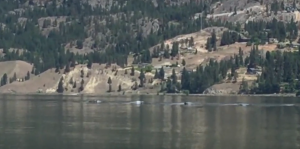New Ogopogo Video
 A new video recently surfaced purporting to show the Ogopogo monster that inhabits Lake Okanagan in British Columbia, Canada. It seems to display a long, slender body, some humps and even flippers coming up out of the water. The creature’s total length seems unrealistic. But how long is a sea serpent? We really don’t know this type of creature from the fossil record. However, numerous marine serpent stories have been recorded from the great age of sailing ships (1500-1900 A.D.) when sailors plied the seas much more quietly than with today’s motorized vessels. The oldest reliable sea serpent record we have was set down by Olaus Magnus in his book Historia de Gentibus. The story describes a Catholic priest who was exiled from his Swedish homeland in 1522 and saw a sea monster “of an astonishing size” (about 23 meters or 75 ft long) that was near an island named Moo. Magnus’s credibility is strengthened by his later producing his most famous work, the 1539 book Carta Marina. This wonderful book presented the most accurate map of Scandinavia or any other European region in existence at the time. He even showed a drawing of a sea serpent on the edge of his map. To find out more about the serpent-like Ogopogo, click on Genesis Park’s Ogopogo page. It details numerous other sightings of this lake monster, including my 2011 encounter.
A new video recently surfaced purporting to show the Ogopogo monster that inhabits Lake Okanagan in British Columbia, Canada. It seems to display a long, slender body, some humps and even flippers coming up out of the water. The creature’s total length seems unrealistic. But how long is a sea serpent? We really don’t know this type of creature from the fossil record. However, numerous marine serpent stories have been recorded from the great age of sailing ships (1500-1900 A.D.) when sailors plied the seas much more quietly than with today’s motorized vessels. The oldest reliable sea serpent record we have was set down by Olaus Magnus in his book Historia de Gentibus. The story describes a Catholic priest who was exiled from his Swedish homeland in 1522 and saw a sea monster “of an astonishing size” (about 23 meters or 75 ft long) that was near an island named Moo. Magnus’s credibility is strengthened by his later producing his most famous work, the 1539 book Carta Marina. This wonderful book presented the most accurate map of Scandinavia or any other European region in existence at the time. He even showed a drawing of a sea serpent on the edge of his map. To find out more about the serpent-like Ogopogo, click on Genesis Park’s Ogopogo page. It details numerous other sightings of this lake monster, including my 2011 encounter.
Posted on August 6, 2019 by dwoetzel.
